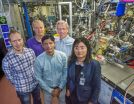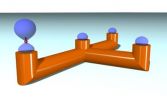(Press-News.org) Skyrmions, subatomic quasiparticles that could play a key role in future spintronic technologies, have been observed for the first time using x-rays. An international collaboration of researchers working at Berkeley Lab's Advanced Light Source (ALS) observed skyrmions in copper selenite (Cu2SeO3) an insulator with multiferroic properties. The results not only hold promise for ultracompact data storage and processing, but may also open up entire new areas of study in the emerging field of quantum topology.
"Using resonant x-ray scattering, we were able to gather unique element-specific, orbital-sensitive electronic and magnetic structural information not available by any other method," says Sujoy Roy, a physicist who oversees research at ALS Beamline 12.0.2 where the study was carried out, and the corresponding author of a paper describing this research in Physical Review Letters titled Coupled Skyrmion Sublattices in Cu2OSeO3.
"We found the unexpected existence of two distinct skyrmion sub-lattices that rotate with respect to each other, creating a moiré-like pattern," Roy says. "Compared to materials with a simpler magnetic structure, the sub-lattices provide for an extra degree of freedom to minimize the free energy. This leads to magnetic excitations that can't exist in materials with a single magnetic lattice structure."
Although skyrmions act like baryons, they are actually magnetic vortices – discrete swirls of magnetism - formed from the spins of charged particles. Spin is a quantum property in which the charged particles act as if they were bar magnets rotating about an axis and pointing in either an "up" or "down" direction. The discovery of skyrmions – named for Tony Skyrme, a British physicist who first theorized their existence - in manganese silicide generated much excitement in the materials sciences world because their exotic hedgehog-like spin texture is topologically protected – meaning it can't be perturbed. Add to this the discovery that skyrmions can be moved coherently over macroscopic distances with a tiny electrical current and you have a strong spintronic candidate.
"A major breakthrough came with the discovery of skyrmions in copper selenite because its magnetic properties can be controlled with an electric field," says Roy. "To achieve this control, however, we must understand how different electron orbitals stabilize the skyrmionic phase. Until our study, the copper selenite skyrmions had only been observed with neutron scattering and transmission electron microscopy, techniques that are insensitive to electron orbitals."
ALS Beamline 12.0.2 is an undulator beamline with experimental facilities optimized for coherent x-ray scattering studies of magnetic materials. The collaboration, which included researchers from Berkeley Lab's Materials Sciences Division and Japan's RIKEN institute, used these facilities to first identify the magnetic vortex. Then, at a certain applied electric field and temperature, they saw x-ray signals due to the formation of a skyrmion lattice.
"We were able to show that although the skyrmions act like magnetic particles, their origin in copper selenite is electronic," says Matthew Langner, lead author of the Physical Review Letters paper. "We also found that temperature can be used to move the skyrmions in copper selenite in either a clockwise or counter-clockwise direction."
Controlling the movement of skyrmions in a multiferroic compound suggests these magnetic vortices could be used to read and write data. Skyrmions are considered especially promising for the holographic information storage concept known as magnetic race-track memory.
"The skyrmion is topologically distinct from the other ground-state magnetic structures, meaning it can be moved around the sample without losing its shape," Langner says. "The combination of this stability and the low magnetic and electric fields required for manipulating the skyrmions is what makes them potentially useful for spintronic applications."
In addition to device applications, the collaboration's findings show that is now possible to use x-rays to study spectroscopic and electronic aspects of the skyrmion, and to study skyrmion dynamics on the time-scale of fundamental interactions.
Co-authors of the Physical Review Letters paper, in addition to Roy and Langner, are Shrawan Mishra, Jason Lee, Xiaowen Shi, Muhammad Hossain, Yi-De Chuang, Shinichiro Seki, Yoshinori Tokura, Stephen Kevan and Robert Schoenlein.
This research was supported by the U.S. Department of Energy's Office of Science.
INFORMATION:
Lawrence Berkeley National Laboratory addresses the world's most urgent scientific challenges by advancing sustainable energy, protecting human health, creating new materials, and revealing the origin and fate of the universe. Founded in 1931, Berkeley Lab's scientific expertise has been recognized with 13 Nobel prizes. The University of California manages Berkeley Lab for the U.S. Department of Energy's Office of Science. For more, visit http://www.lbl.gov.
The DOE Office of Science is the single largest supporter of basic research in the physical sciences in the United States and is working to address some of the most pressing challenges of our time. For more information, please visit science.energy.gov.
Advanced light source provides new look at skyrmions
Results hold promise for spintronics
2014-06-25
ELSE PRESS RELEASES FROM THIS DATE:
Reorganization of crop production and trade could save China's water supply
2014-06-25
PRINCETON, N.J.—China's rapid socioeconomic growth continues to tax national water resources – especially in the agricultural sector – due to increasing demands for food. And, because of the country's climate and geography, irrigation is now widespread, burdening rivers and groundwater supplies.
One solution to these growing problems, however, might be to reorganize the country's crop production and trade, especially in agricultural provinces such as Inner Mongolia, Heilongjiang and Hebei, according to new report issued by Princeton University's Woodrow Wilson School ...
Collaborative learning -- for robots
2014-06-25
Machine learning, in which computers learn new skills by looking for patterns in training data, is the basis of most recent advances in artificial intelligence, from voice-recognition systems to self-parking cars. It's also the technique that autonomous robots typically use to build models of their environments.
That type of model-building gets complicated, however, in cases in which clusters of robots work as teams. The robots may have gathered information that, collectively, would produce a good model but which, individually, is almost useless. If constraints on power, ...
Are fish near extinction?
2014-06-25
"An end to seafood by 2050?" "Fish to disappear by 2050?" These sensational media headlines were the result of a 2010 report by the United Nations Environment Program, declaring that over-fishing and pollution had nearly emptied the world's fish stocks. That scarcity portends disaster for over a billion people around the world who are dependent on fish for their main source of protein.
Now, a new study by Dr. Roi Holzman and Victor China of the Department of Zoology at Tel Aviv University's George S. Wise Faculty of Life Sciences has uncovered the reason why 90% of fish ...
Fifty percent of quality improvement studies fail to change medical practices
2014-06-25
Over the last two decades, nearly half of all initiatives that review and provide feedback to clinicians on healthcare practices show little to no impact on quality of care, according to a new study by Women's College Hospital's Dr. Noah Ivers.
The study, published in the Journal of General Internal Medicine, found only 28 per cent of all studies showed an improvement of at least 10 per cent in quality of care over a 25-year period.
"Research shows there is a gap between recommended practices and the care patients actually receive," said Dr. Noah Ivers, a family physician ...
Fracking flowback could pollute groundwater with heavy metals
2014-06-25
VIDEO:
This video visualizes the effects of hydrofracking flowback fluid on colloid mobilization in unsaturated sand. Included are the injection of the colloids into the sand column at the beginning of...
Click here for more information.
ITHACA, N.Y. – The chemical makeup of wastewater generated by "hydrofracking" could cause the release of tiny particles in soils that often strongly bind heavy metals and pollutants, exacerbating the environmental risks during accidental spills, ...
LSTM Researchers demonstrate adaptive potential of hybridization in mosquito species
2014-06-25
Researchers from LSTM have exploited a natural experiment created by insecticidal pressure to determine how the most important malaria vectors - A. gambiae s.s. and A. coluzzii – respond rapidly to environmental change.
Working with genome analysis specialists from the Wellcome Trust Sanger Institute and field entomologists in Ghana, LSTM researchers sequenced the genomes of individual wild mosquitoes of each species from southern Ghana. The results, published in Nature Communications, reveal that transfer of a major insecticide resistance mutation (kdr) resulted in replacement ...
World's first magnetic hose created
2014-06-25
The magnetic hose designed by the researchers consists of a ferromagnetic cylinder covered by a superconductor material, a surprisingly simple design given the complicated theoretical calculations and numerous lab tests it had to undergo. A 14-centimeter prototype was built, which transports the magnetic field from one extreme to the other with a efficiency of 400% in comparison to current methods used to transport these fields.
Even with the efficiency of the prototype, researchers theoretically demonstrated that the magnetic hose can be even more efficient if the ferromagnetic ...
New method increases targeted bone volume by 30 percent
2014-06-25
In an important development for the health of elderly people, University of Liverpool researchers have developed a new method to target bone growth.
As people age their bones lose density and, especially in women after the menopause, become more brittle. The new method developed by researchers from the University's Institute of Ageing and Chronic Disease offers the possibility of more effective treatment than currently available.
Professor Jonathan Jarvis of Liverpool John Moores University designed miniature muscle pacemakers that were used in the University of Liverpool ...
Peer problem solving leads to operational efficiency
2014-06-25
Chestnut Hill, MA (June 25, 2014) - Strength in numbers may not just be a truism for those seeking moral and emotional support, but it also may be an avenue for those seeking customer support. New research shows peer-to-peer problem solving can lessen the need for firms to actually have to contact their supplier for a traditional customer support service call.
"This has never been shown before, this notion that people who have full-time day jobs handling support for their companies also take time to answer other people's questions, thereby significantly reducing their ...
Deep brain stimulation improves non motor symptoms in Parkinson's disease
2014-06-25
Amsterdam, NL, 25 June 2014 – Deep brain stimulation (DBS) has become a well-recognized non-pharmacologic treatment that improves motor symptoms of patients with early and advanced Parkinson's disease. Evidence now indicates that DBS can decrease the number and severity of non motor symptoms of patients with Parkinson's disease (PD) as well, according to a review published in the Journal of Parkinson's Disease.
"Non motor features are common in PD patients, occur across all disease stages, and while well described, are still under-recognized when considering their huge ...
LAST 30 PRESS RELEASES:
Strategic river sensors could have forewarned of Texas Camp flood disaster
Drone sampling of whale breath reveals first evidence of potentially deadly virus in Arctic
Roman soldiers defending Hadrian’s Wall infected by parasites, study finds
Pinochet’s prisoners were tormented with music but still found solace in it, a new book reveals
Fertility remains high in rural Tanzania despite access to family planning
AI-assisted device can improve autism care access
Kinetic careers
Uncovering how parasitic plants avoid attacking themselves to improve crop resistance
Nanoparticle vaccine strategy could protect against Ebola and other deadly filoviruses
Study finds brain care score can predict risk of stroke across racial groups
Key lung immune cells can intensify allergic reactions
Do hormones explain why women experience more gut pain?
New materials conduct ions in solids as easily as in liquids
Breakthrough of the Year: Renewable energy begins to eclipse fossil fuel-based sources
LLM use is reshaping scientific enterprise by increasing output, reducing quality and more
Introducing LightGen, a chip for ultra-fast, ultra-efficient generative AI
Astronomers see fireworks from violent collisions around nearby star
ACC/AHA issue new guideline on managing congenital heart disease in adults
Cosmic crash caught on camera
Is talented youth nurtured the wrong way? New study shows: top performers develop differently than assumed
Ants: An untapped resource in the development of antibiotics?
Archaeologists use AI to create prehistoric video game
Mitochondria migrate toward the cell membrane in response to high glucose levels
Tiny viral switch offers hope against drug-resistant bacteria
Most parents aware of early peanut introduction guidelines, but confused about details
HPV vaccine can protect against severe lesions of the vulva and vagina
Virtual care provision and emergency department use among children and youth
Quadrivalent HPV vaccine and high-grade vulvovaginal lesions
Insights into dry eyes gained from stem cell-derived tear glands
Researchers identify 166 human pluripotent stem cell lines available for use in clinical applications
[Press-News.org] Advanced light source provides new look at skyrmionsResults hold promise for spintronics





